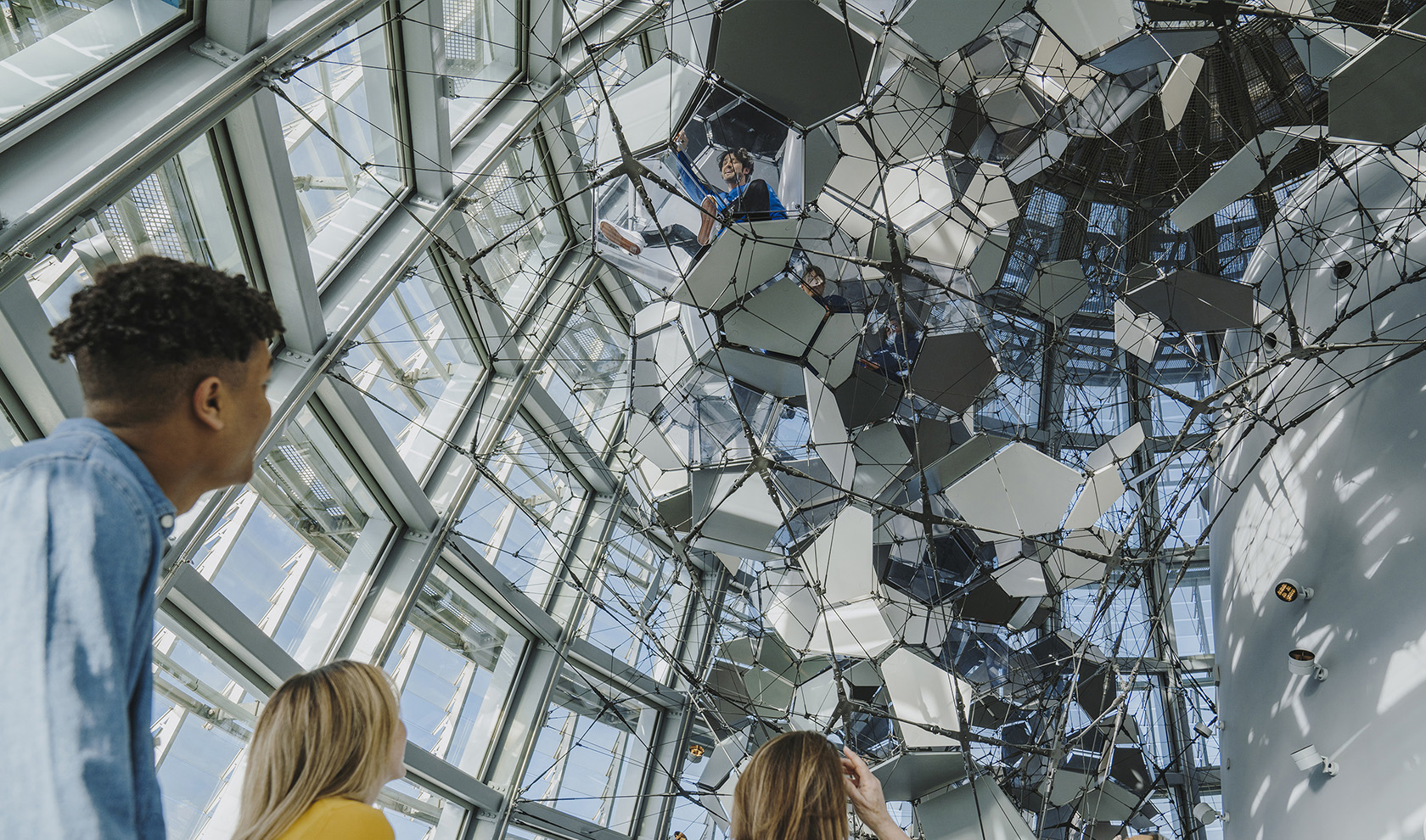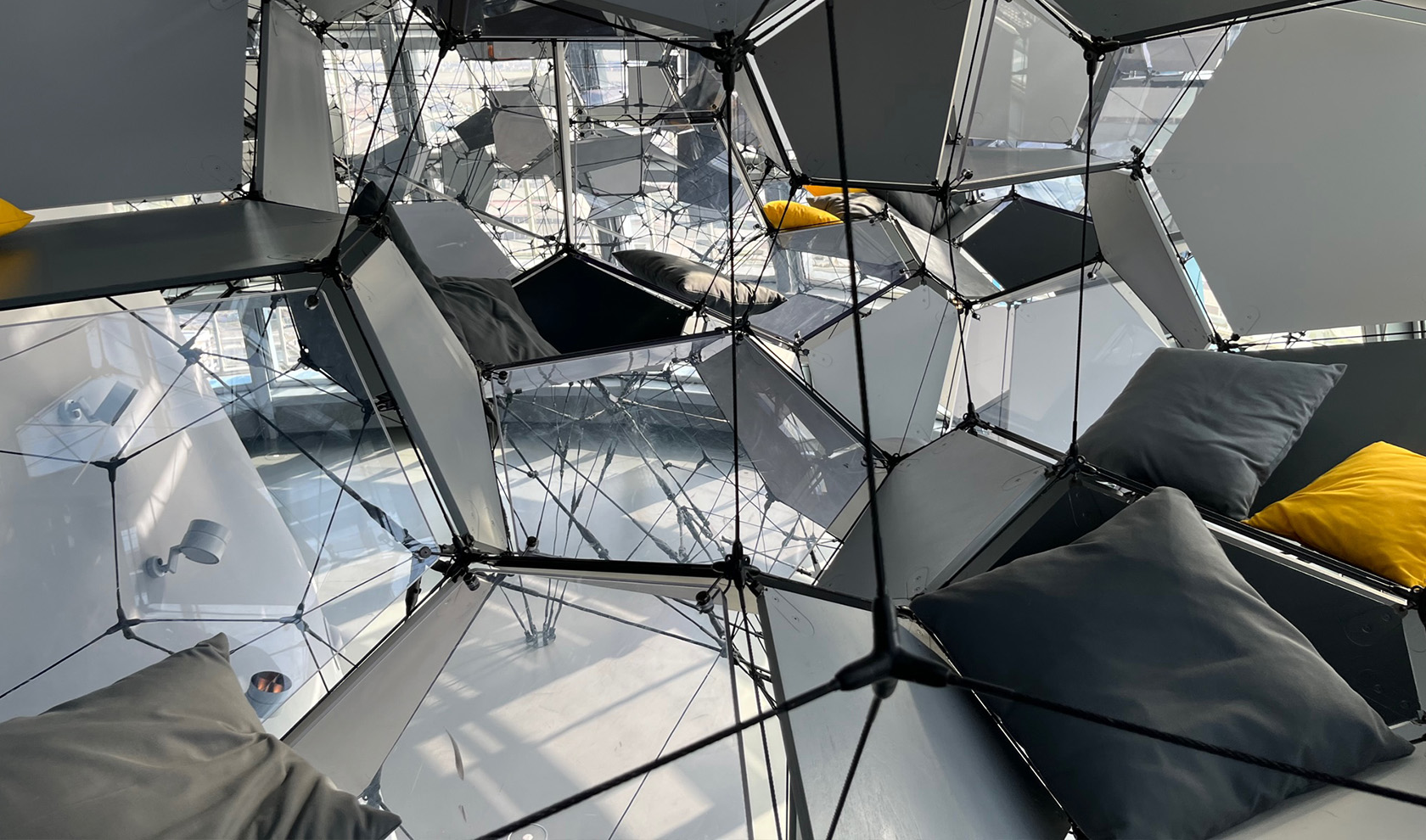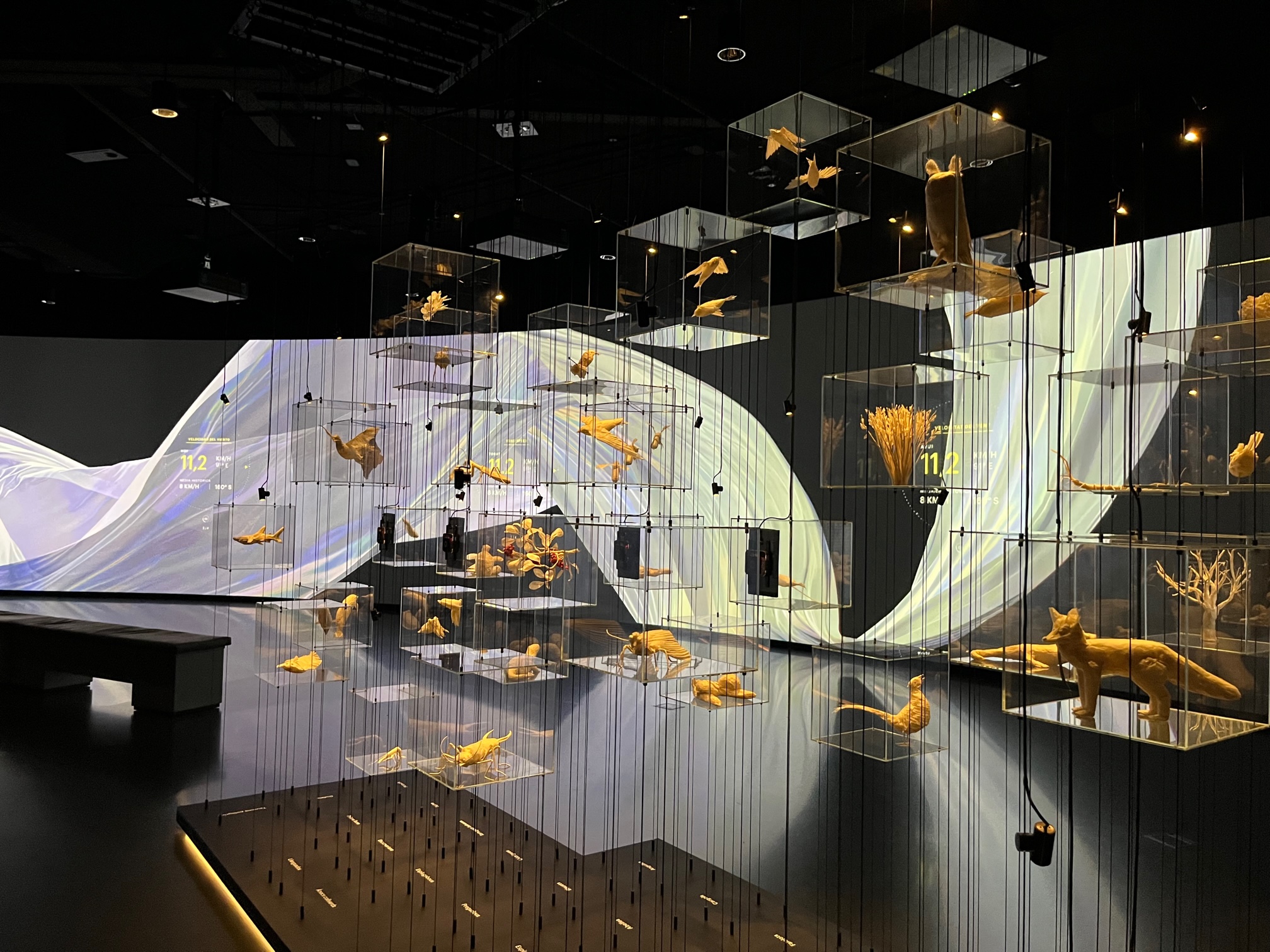The artist Tomás Saraceno installed his work “Cloud Cities Barcelona” in the Torre Glòries of Barcelona, a structure that combines art, technology, science, and environmental awareness.
Ascending to the 30th floor of a building is more typical of metropolises like New York than our Barcelona. However, the new installation of Tomás Saraceno’s “Clouds Cities Barcelona” on the dome of the Mirador Torre Glòries reinterprets the concept of a conventional viewpoint to transform it into a multisensory and immersive narrative.
The building housing this fascinating work, which Jean Nouvel completed in 2005, is an ode to warm verticality. In the tower’s rounded dome, one gets the sensation of being able to touch the clouds through the windows, the same “clouds” or “condensed water droplets” suspended in the air by thousands of custom-made cables that are part of the installation. Some may be reminded of the fragile threads of spiderwebs, while others may see a labyrinth suspended from the ceiling to wander and lose themselves for a moment.

Interview with Aleix Pratdepàua, director of Mirador Torre Glòries
We spoke with Aleix Pratdepàdua, the director of the Mirador Torre Glòries, where he states that visitors can freely explore the 130m2 structure, where they will find spaces to relax with cushions and architecture books selected by the artist himself.
The work invites you to look both inward and outward and reflect on the urban public sphere, as well as the environmental crisis. “Clouds Cities” is a unique experience to observe Barcelona as it has never been seen before.
Llucià Homs: What is the perception that visitors have with the Tomás Saraceno experience?
Aleix Pratdepàdua: The Tomás Saraceno experience can be experienced from two positions: On one hand, the mere contemplation of the sculpture, which is the largest that Tomás has permanently built. The fact of entering here, on the 30th floor, and seeing the 360º views of Barcelona at the same time is already an experience because it sparks a debate as visitors don’t know where to look: do I look at Barcelona, the sculpture? And it’s a bit overwhelming. From a purely aesthetic point of view, the experience is positive.

Viewpoint where you can see the sculpture with a pedestrian inside and seen by other visitors from below.
On the other hand, visitors can walk inside the sculpture and complete the entire circuit, crossing this floating cloud “Clouds Cities Barcelona” from the dome of Torre Glòries. Staying in the designated seating areas, resting, and reading, where a comfort zone is generated, and people feel the sensation that they are in an alien, different environment, on the edge of the comfort zone because it requires some courage to enter here, seeing at your feet through the sculpture the void, the emptiness, does require a certain sensitivity or daring.

Interior Mirador Torre Glòries Cloud Cities Barcelona with rest areas
L.H. What is the Barcelona that is seen from the Mirador that is not really seen?
A.P. From the Mirador Torre Glòries, visitors can come to understand the city as an ecosystem: “a system of systems, like a living organism that is made up of different elements all in a network of relationships, exchanges, contacts, intersections… A tapestry of interrelations where all the elements shape the urban ecosystem of Barcelona.”
L.H. What is the relationship between this viewpoint and other buildings in the city? To be more specific, with such an emblematic building as the Sagrada Familia, which seems to be in close proximity?
It is an indirect relationship; the architect Jean Nouvel, the father of this building, was influenced by elements of Catalan culture, such as one of the bell towers of Gaudí’s Sagrada Familia, and also by Montserrat, with the rounded shapes of the tower that directly emulate the rounded shapes of the Montserrat mountain, a reference for Catalonia. Likewise, this dialogue goes a little further with this sculpture by Tomás Saraceno, in which one of its inspirations was also Gaudí with this whole network of steel cables that draw from the entire system of catenaries by Antoni Gaudí.
L.H. What is the singularity that makes this viewpoint unique?
A.P. The Mirador Torre Glòries aims to transcend the conventional viewpoint to which we are accustomed. Through a journey through the “Hyper-view Barcelona” exhibition, which is located underground in the tower, it provides visitors with elements that allow them to obtain a different perspective of the city:
“It abandons the passive and contemplative gaze of conventional viewpoints to adopt a conscious and responsible view of the ecosystem that surrounds it.”

The acclaimed Badalonese artist Joan Sallas created 132 pieces of paper representing the species found in the city of Barcelona.
The Hyper-view Barcelona is made up of several installations where art, technology, science, and environmental awareness dialogue at the same level. They aim to be instruments that help visitors understand the city as a web, a network of disparate points, but at the same time connected. “In the prologue of the Hyper-view Barcelona, it reflects on the different elements in the city. No single element defines the city for you; it is all together that gives identity to this ecosystem that is Barcelona.”

The large-format projector, 27 meters long by 4 meters high, reveals the different types of atmosphere, and in some cases, in real-time.
L.H. What does Barcelona tell us when we contemplate it from this viewpoint?
A.P. The view we have from Barcelona is a view of the global environment that we have as a world society today and the challenges we are facing, not from the individuality of the citizen, but also referring to a fabric of interrelationships that we all humans have to face in the coming years to decide what kind of city we project towards the future.
The viewpoint tries to give some clues as to where the city can go, and it is up to the visitor to judge them and decide which one they think may be best for it. They are challenges aligned with the United Nations’ 2030 Agenda on sustainability, city habitability, pollution.
From the viewpoint, the question may arise:
“This is what we have today, based on these views and this perspective, what do you want for the future?”
L.H. Let’s change the angle… How do you think Barcelona sees the viewpoint?
A.P. Barcelona has changed the view of the tower. The tower was the distinctive element of the city, part of its skyline. However, it was a building that, although it was a reference, was closed to the entire population. The fact of being able to open the tower through the viewpoint means that there is a sympathy with this emblematic building that we hope people end up making their own, and I dare say that finally the city of Barcelona, innovative and creative, regains with this viewpoint the creative heartbeat of the city.

Night view of the illuminated Glòries Tower in Barcelona
Time passes quickly contemplating Barcelona from the sky. The city from above has something of a model that makes it manageable, and so the combination of the viewpoint and Saraceno’s installation infuses the visitor with a special energy that makes them feel that with the visit, the city is a little more known, a little more theirs. And they feel the privilege of seeing their beloved Barcelona from a wonderful perspective as they had never been able to contemplate it before.
You can purchase tickets at the box office open every day from 10 a.m. to 7:45 p.m., although it is advisable to purchase them in advance through the Internet www.miradortorreglories.com, a reservation that is mandatory to access “Cloud Cities.” Prices range from 15 to 25 euros.




